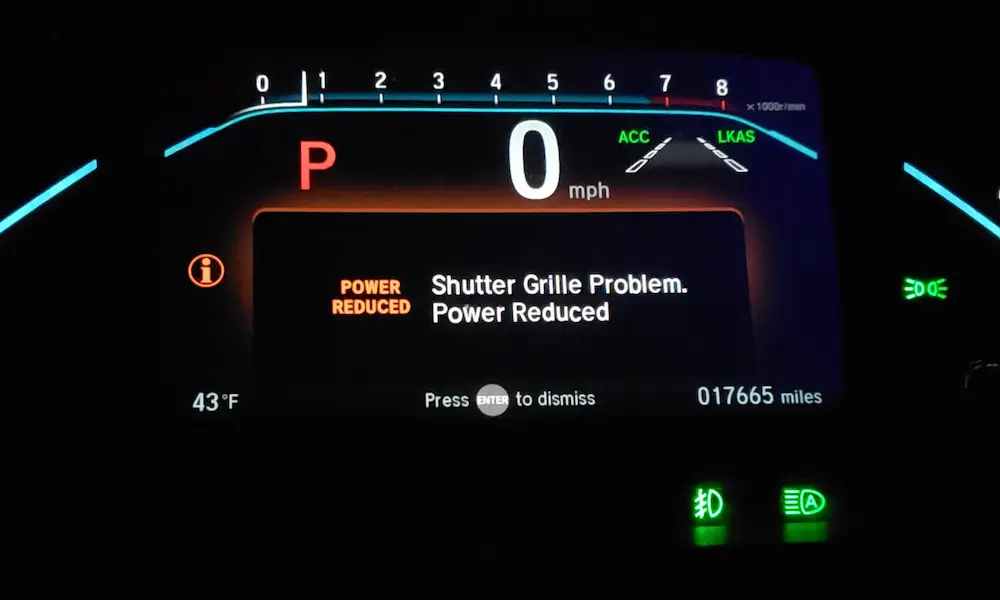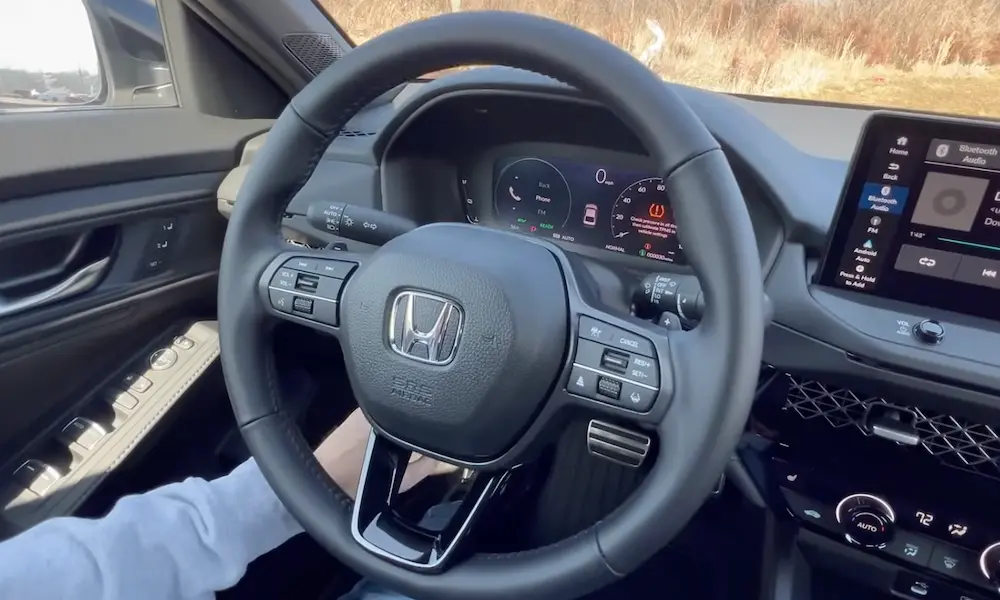Ever glanced at your dashboard only to see that annoying orange tire pressure light staring back at you? You’re in the right place. Whether you’ve just filled your tires or swapped them out entirely, knowing how to reset that persistent warning light is an essential skill for any Honda CR-V owner.
Why Your Honda CR-V’s Tire Pressure Light Comes On
The tire pressure monitoring system (TPMS) in your CR-V isn’t just another dashboard feature – it’s a critical safety system that monitors your tires’ pressure levels. When the system detects one or more underinflated tires, it triggers that distinctive warning light.
Your CR-V’s TPMS works by comparing the rolling radius of each tire. When one tire rotates differently than the others, the system recognizes this as a potential pressure issue and alerts you by illuminating the dashboard indicator. According to the National Highway Traffic Safety Administration, properly inflated tires are crucial for vehicle safety, handling, and fuel efficiency.
When You Need to Reset Your Honda CR-V’s TPMS
There are several situations when you’ll need to reset the tire pressure light:
After Adding Air to Your Tires
This is the most common scenario. When your tires are low and you’ve added air to the recommended pressure level, you’ll need to recalibrate the system so it can recognize the new baseline pressure.
Following Tire Rotation or Replacement
Any time you rotate your tires or replace one or more of them, the system needs to be reset. The TPMS needs to learn the new position or characteristics of each tire.
During Seasonal Temperature Changes
Did you know tire pressure naturally drops in cold weather? For every 10°F drop in temperature, your tires can lose about 1 PSI of pressure. When winter arrives, don’t be surprised if that TPMS light makes an appearance. After adjusting the pressure, you’ll need to reset the system.
When the Light Won’t Turn Off on Its Own
Sometimes, even after properly inflating your tires, that stubborn light stays on. This is your cue to manually reset the system.
How to Reset Tire Pressure Light on Honda CR-V (By Model Year)
The reset procedure varies slightly depending on your CR-V’s model year and configuration. Here’s a comprehensive breakdown:
Method 1: Resetting TPMS on 2023-2025 CR-V Models with Touchscreen
Newer Honda CR-V models make the reset process straightforward:
- Park your vehicle and turn the ignition to ON
- Tap the “Home” button on your touchscreen
- Select “Settings” or “Vehicle Settings”
- Choose “TPMS Calibration”
- Tap “Calibrate”
The system will display a confirmation message, and calibration will begin. You’ll need to drive for about 30 minutes at speeds between 30-65 mph to complete the process.
This method applies to the latest CR-V models equipped with the 9-inch touchscreen interface.
Method 2: Resetting TPMS on 2017-2022 CR-V Models
For these slightly older models with the driver information interface:
- Start your CR-V
- Press the “Home” button on the left side of the steering wheel
- Use the scroll wheel to navigate to “Settings” and press to select
- Scroll to “TPMS Calibration” and select it
- Choose “Calibrate” and press to confirm
The calibration process will initiate, and you’ll need to drive the vehicle to complete it.
Method 3: Resetting TPMS on 2012-2016 CR-V Models
Older CR-V models use a slightly different method:
- Using the buttons on the lower right of the steering wheel, scroll through the menu options
- Stop when you see a screen that resembles two pages of a book
- Press the select button (pull it toward you)
- Use the up/down buttons to find “Deflation Warning System” (typically option 2 of 6)
- Press select again
- Scroll to “Initialize” (not “Cancel”)
- Press select to confirm
The system will initiate the calibration process, which completes as you drive.
Method 4: Using the TPMS Button (Some 2007-2011 Models)
Some older Honda CR-V models have a dedicated TPMS reset button:
- Locate the TPMS button to the left of the steering column (under the dashboard)
- With the ignition on, press and hold this button until the TPMS light blinks three times
- Release the button
According to dealer information, you’ll need to drive for several minutes to complete the calibration.
Method 5: Reset Through Instrument Panel (Pre-2012 Models)
For the earliest CR-V models with TPMS:
- Turn the ignition to ON (don’t start the engine)
- Press and hold the Menu button on the instrument panel
- Navigate to the maintenance menu
- Select TPMS initialization
- Choose “Yes” to confirm
How to Check and Maintain Proper Tire Pressure
Before resetting your TPMS, ensure your tires are properly inflated. Here’s how:
Finding Your CR-V’s Recommended Tire Pressure
You’ll find the recommended pressure levels for your specific CR-V on:
- The driver’s side door jamb sticker
- Your owner’s manual
- The fuel door on some models
Most Honda CR-Vs require around 32-35 PSI for optimal performance. Some models specify different pressures for front and rear tires (typically 35 PSI front, 32 PSI rear).
Using a Tire Pressure Gauge Correctly
For accurate readings:
- Check pressure when tires are “cold” (vehicle hasn’t been driven for at least 3 hours)
- Remove the valve cap
- Press the gauge firmly onto the valve stem
- Read the displayed pressure
- Replace the valve cap securely
| When to Check Tire Pressure | Why It Matters |
|---|---|
| Monthly | Prevents gradual pressure loss from going unnoticed |
| Seasonal changes | Temperature affects pressure levels |
| Before long trips | Ensures safety during extended driving |
| When carrying heavy loads | Extra weight requires proper inflation |
Troubleshooting Persistent TPMS Issues
Sometimes your tire pressure light might continue to cause problems even after reset attempts. Here’s how to troubleshoot common issues:
TPMS Light Stays On After Reset
If the light remains illuminated:
- Double-check that all tires (including the spare in some models) are properly inflated
- Ensure you completed all reset steps correctly
- Try the reset procedure again, following manufacturer instructions precisely
- Drive your vehicle for at least 30 minutes to complete the calibration process
TPMS Light Flashing Instead of Solid
A flashing TPMS light indicates a system malfunction rather than a simple pressure issue. This could be caused by:
- Failed TPMS sensors
- Battery failure in one or more sensors
- Sensor damage during tire mounting
- Electronic system interference
When the light flashes for about one minute each time you start your CR-V before staying continuously lit, it’s signaling a system problem that requires professional diagnosis.
TPMS Light Returns Shortly After Reset
If the light comes back on soon after resetting:
- Check for slow leaks using soapy water on the valve stems and tire surfaces
- Look for nails or other puncturing objects in the tires
- Have your tires inspected by a professional
According to Honda’s technical information, rapid pressure loss after inflation often indicates a tire defect.
The Importance of Proper Tire Pressure
Maintaining correct tire pressure isn’t just about keeping that annoying dashboard light off. It affects:
Safety Benefits
Properly inflated tires:
- Improve braking performance
- Enhance steering response
- Maintain better traction in wet conditions
- Reduce the risk of catastrophic tire failure
Performance and Economic Advantages
The right tire pressure also:
- Improves fuel efficiency by up to 3%
- Extends tire life by promoting even wear
- Provides more comfortable ride quality
- Reduces strain on your CR-V’s suspension components
Seasonal Tire Pressure Considerations for Honda CR-V Owners
Your tire pressure fluctuates with the seasons, and understanding these changes will help you maintain proper pressure year-round:
Winter Tire Pressure Management
During winter:
- Check pressure more frequently, ideally weekly
- Remember that pressure drops approximately 1 PSI for every 10°F temperature decrease
- Don’t reduce pressure for better snow traction (this is a dangerous myth)
- Consider that heated garages can temporarily increase pressure readings
Summer Tire Pressure Management
In warmer months:
- Be aware that pressure increases with heat
- Don’t release air from “hot” tires that read high
- Check pressure during cooler morning hours for accurate readings
- Be especially vigilant during heat waves
How Honda’s TPMS Differs From Other Systems
Honda CR-V models use an “indirect” TPMS system, which differs from the “direct” systems used in some other vehicles:
| Indirect TPMS (Honda CR-V) | Direct TPMS (Some Other Vehicles) |
|---|---|
| Uses wheel speed sensors | Uses physical pressure sensors in each tire |
| Compares rotation speeds between tires | Directly measures actual pressure |
| Requires manual reset after pressure adjustments | May automatically adjust to new pressure levels |
| No battery replacement required | Sensors contain batteries that eventually need replacement |
| Generally more affordable to maintain | Can be more costly to service |
Understanding these differences helps explain why the reset procedure is necessary in your Honda CR-V.
Common Questions About Honda CR-V TPMS Reset
Let’s address some specific questions CR-V owners frequently ask:
How Long Does the Reset Process Take?
The actual button-pressing or menu navigation takes less than a minute. However, the calibration process requires driving for about 20-30 minutes at speeds between 30-65 mph.
Some newer CR-V models may complete calibration faster, sometimes within 10 minutes of normal driving.
Can I Reset the TPMS Without Any Special Tools?
Yes! Honda designed the CR-V’s TPMS to be reset without special tools. All you need is access to your vehicle’s dashboard controls or touchscreen interface.
Will the TPMS Reset Itself Eventually?
No. Unlike some vehicle systems, Honda’s TPMS requires manual reset after pressure adjustments. It won’t automatically recalibrate itself, even if tire pressures are corrected.
Does the TPMS Monitor the Spare Tire?
Most CR-V models don’t monitor the spare tire. However, it’s still important to check your spare’s pressure regularly as part of routine maintenance.
Can I Drive with the TPMS Light On?
While you can physically drive with the light on, it’s not recommended. The light indicates a safety concern that could affect handling, fuel economy, and tire lifespan. Address the issue promptly when it appears.
When Professional Help Might Be Needed
While most TPMS resets can be handled by CR-V owners, there are situations where professional assistance may be necessary:
- When the TPMS light flashes continuously (indicating system malfunction)
- If you’ve attempted multiple resets without success
- When you suspect a faulty TPMS sensor
- If you notice unusual tire wear patterns despite proper inflation
Most Honda dealerships and tire shops can diagnose and repair TPMS issues, often during regular maintenance visits.
By understanding how your CR-V’s tire pressure monitoring system works and knowing the correct reset procedure for your specific model year, you can easily maintain proper tire pressure – keeping your vehicle safe, efficient, and performing at its best.














